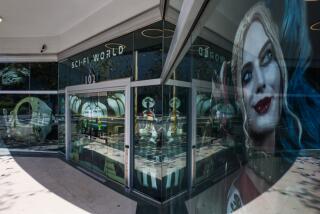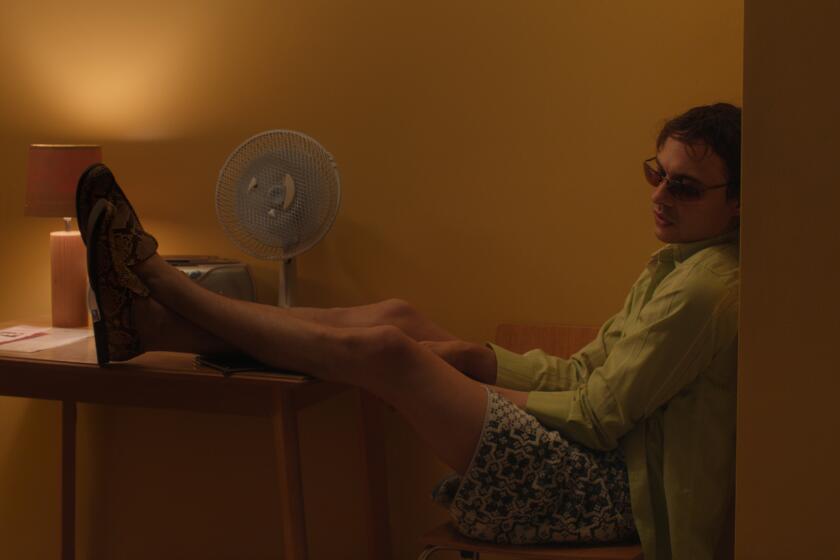Building Momentum, From the Bones Up
- Share via
CHICAGO — Sue the dinosaur has been here only six months, but already the charismatic Tyrannosaurus rex is approaching icon status in Chicago.
“Jurassic Park” did huge business at the box office, but the suspenseful story of how Sue--the largest, most complete, best-preserved T. rex skeleton ever found--got to the Field Museum of Natural History might make for a better story.
The $8.3-million transaction was masterminded by one man, museum Chief Executive John McCarter, who, though he has been on the job only since 1996, has used a mix of creativity, business skill, hunch and chutzpah to help make the Field the most visited museum in Chicago.
McCarter undertook the 1997 acquisition of Sue after an inspection of the fossil by his own museum experts. The 42-foot-long skeleton had been found in South Dakota in 1990 by fossil hunter Sue Hendrickson. McCarter moved quickly to organize a delicate consortium of resources from the private and public sectors to pull off the unprecedented deal, which featured dramatic, secret bidding at a New York auction house.
What gets lost in a retelling of the tale is this: At the time McCarter made the decisive moves, committing the Field to a costly gamble, he had been at the helm for less than a year. What’s more, it was a job for which he had no experience.
“If you don’t grow up in an institution, you’ve got to be careful you don’t overreach your capabilities,” he said, as if reminding himself. “I consult with our scientists on every scientific matter before making decisions. Almost every experience I had before has come into play here. It’s been exhilarating and surprising and amazing here, but I’ve never felt intimidated.”
The Field hit the 2-million-visitor mark for the year in October, a figure that hasn’t been seen at the museum since the King Tut year of 1977. But it was a goal set by McCarter almost from Day 1. The Field is certain to be the most visited Chicago museum in 2000, an honor that has gone to the John G. Shedd Aquarium the last four years and either the Museum of Science and Industry or Art Institute of Chicago for the remainder of the 1990s.
The investment in Sue (a replica of which is now on display at the Natural History Museum of Los Angeles County) figures to pay dividends well into the new century, but the dinosaur is just one of a number of attractions that have energized Field attendance on McCarter’s watch.
Perhaps as telling about the 62-year-old CEO’s leadership style is how he acquired another top draw this year--the Dead Sea Scrolls.
In this case, the peripatetic McCarter was in Scotland scouting the Edinburgh Festival for ideas when he saw a bus with a sign advertising the scrolls in a Glasgow museum. Intrigued, he detoured to that Scottish city, saw large crowds lining up and, after consulting with locals responsible for bringing them there, told his staff: “We’ve got to have them.”
The wheels were soon set in motion for the scrolls to come to the Field--the bulk of them being shown in the U.S. for the first time. Just as impressive was the ecumenical consortium of sponsors organized by the museum, which included the Chicago Catholic Archdiocese, Chicago’s Fourth Presbyterian Church, the Church of Jesus Christ of Latter-day Saints and the Israeli consulate.
“When one museum does well, it’s great for all the other museums,” said Charles Katzenmeyer, an associate director with the Smithsonian Institution in Washington, D.C. “The Field is one of the great natural history museums of the world, and its scientists are at the core of important things. From our standpoint, we couldn’t be happier at the success the Field is having.
“John McCarter understands the audience of the museum and that he sets the direction for what it can do,” he added. “He’s a real dynamo when it comes to fresh ideas for great institutions. He understands how to formulate an idea, articulate it, enforce it and fund it.”
McCarter came to the Field Museum after two stints with the consulting firm Booz Allen & Hamilton Inc., where it was his job to implement ideas and strategies for an international list of clients.
He spent the 13 years in between with DeKalb Corp., rising to the presidency of the giant agricultural firm, and served on well-connected boards at the University of Chicago and WTTW-TV, where he ushered in the station’s move to airing commercial messages.
In a basement corridor leading to his office is a reminder of the challenge of maintaining the museum’s competitiveness. A stretch of ceiling tiles has been peeled away by workers, exposing a maze of wires and pipes being replaced in the ongoing attempt to keep the nearly 80-year-old building up to speed.
The Field’s older exhibit halls are “embarrassingly” out of date, McCarter said. The manner in which the extensive Native American collection is physically displayed is “straight out of the 1920s.” Plans to add more room include burrowing under the Field’s southeast terrace to create 170,000 square feet of added, climate-controlled storage space.
“It’s like we’re driving down these parallel roads,” McCarter said, “and I have to make sure resources get allocated in a way that one road doesn’t get more than its share. Not being a scientist, I’m sure I defer more to the academic side when it comes to making decisions, but that doesn’t mean I don’t try to stay on top of things.”
More to Read
The biggest entertainment stories
Get our big stories about Hollywood, film, television, music, arts, culture and more right in your inbox as soon as they publish.
You may occasionally receive promotional content from the Los Angeles Times.










